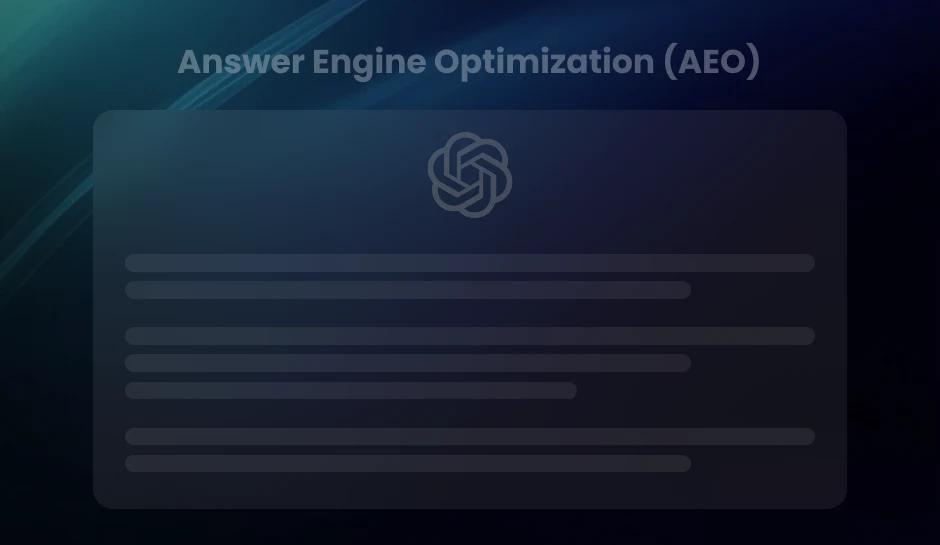Struggling to break through the noise and generate consistent demand? Discover the strategies that top B2B tech marketers are using right now. Join Julie Candelon, a seasoned fractional CMO as she reveals the secrets to building a powerful demand generation engine, driven by data and the smart application of AI. Learn how to cut through vanity metrics, master essential marketing tools, and align your marketing and sales teams for maximum impact, all while staying authentically human in an increasingly automated world.
By tuning in to this episode, you will learn about:
- Unlocking Demand Generation Success
- Future of SEO in the Age of AI
- The Role of Operations in Marketing
Featured Speakers:-

Julie Candelon
Fractional CMO - JM@rketingJulie Candelon is passionate about driving impactful growth for B2B tech and services companies. As a results-driven fractional CMO with over 15 years of experience, she focuses on data-savvy strategies and execution. Julie excels at aligning marketing, demand generation, and sales to generate leads and revenue. She advises and mentors business leaders, helping startups to larger enterprises achieve accelerated global growth through practical and effective marketing solutions.

Harshika Chadha
Lead Product Manager - DiGGrowthHarshika is a seasoned product manager with a passion for business transformation, design thinking, technology, marketing trends, SaaS security, and human-computer interactions. What interests her most is the intersection of these fields, which is why she stays on top of the latest industry insights to uncover strategies for success in today's dynamic business landscape.
More From Our Content Repertoire
- Unveiling the Power of Marketing Intelligence Data: A Catalyst for Informed Decisions
- How AI will EEAT traditional SEO?
- The Human Touch 2.0–Leveraging AI for Deeper, More Meaningful Sales
Transcription:
0:11:
Hello and welcome to another episode of the revenue-focused marketer where we discuss anything and everything related to marketing as well as data.
0:19:
I’m your usual host, Hershey, and today I’m joined with a very special guest.
0:25:
Julie, thank you so much for joining us today.
0:28:
Thank you very much for having me.
0:30:
It’s a pleasure.
0:31:
Yeah, so just a little bit about Julie.
0:34:
Julie is from Jane Marketing.
0:36:
She wears multiple different hats, but she’s also focused in a fractional CMO role.
0:42:
And she’s very results driven, data savvy, and gets things done, kind of a marketer.
0:49:
So we’re really excited to kind of have her here and, you know, talk with a fellow marketing nerd.
0:57:
Yes, thank you.
0:58:
I’m, I’m a fractional CMO and I’ve been for over a decade, even before it was a thing to be fractional.
1:06:
I focus on B2B tech and services, and I’ve been helping companies from Series B startups to much bigger companies all the way to Amazon to turn their marketing around and and drive real growth.
1:21:
So I’m, I’m really excited to share some of my findings for the last decade.
1:26:
Yeah, no, that is so exciting.
1:28:
I love that you have so much experience that, you know, ranges from like startups, but also bigger companies like Amazon, and I think you’ve had over 15 years of experience in leading and scaling marketing for these teams.
1:41:
So I just kind of want to understand, you know, what was the spark that kind of made you shift and create your marketing.
1:50:
, well, when I arrived in the US, , 17 years ago, the economy was not there.
1:56:
So instead of finding jobs, I started finding projects and all of a sudden I ended up creating my own company and little by little I developed additional services up until 2012 when I started really transforming my business to be focused on being fractional and helping companies with their teams, their tech stacks, their strategy, really.
2:19:
aligning marketing with the business needs to find the growth and be successful.
2:24:
So that was a big change and I, I, I like the fact that I’m not really an agency.
2:30:
I’m not really an employee.
2:31:
I’m somewhere in the middle, , and back when people didn’t understand what fractional means, , I was explaining that as being Mary Poppins.
2:42:
I joined the team.
2:44:
I fixed what’s broken, and then when everything is back to normal, I fly away.
2:50:
That is such a wonderful analogy.
2:52:
I love that.
2:53:
So we have our, you know, in-house Mary Poppins today to kind of help us guide to our next direction.
3:00:
I think let’s kind of dive into modern demand generation.
3:05:
I saw a lot of your work kind of focuses on that, and this is a space that has evolved dramatically, right?
3:11:
So how do you define success for demand generation today and what separates average from like, you know, outstanding?
3:19:
, I think, you know, one of the key steps in, in creating a successful DemandGen machine is to have operations in place.
3:29:
, unfortunately, it’s still very much considered as something that is not a necessity by many companies and by many, , CEOs, .
3:40:
I don’t think you can be really making any dent into your, your revenue and going after competition if you don’t have good operations.
3:50:
So that means having the right people with the right mindsets, first of all, , you cannot have a team of marketers that does not understand data and that does not enjoy diving into a spreadsheets or reports or, you know, anything of that matter.
4:06:
You need to have the Right tech stack as well.
4:07:
So there is a budget associated to that, and, and those two are the key pillars for anything that you do after that because, , marketers have ideas and, and that’s not an issue to have the right idea to launch a demand gen campaign.
4:21:
What is the problem is the execution and, and very often the execution lacks correct data or skill sets and so if you fix those two first, then you’re all set.
4:34:
Yeah, definitely.
4:35:
So maybe you can give us like, you know, a detailed example of how you build and executed demand gen strategy that, you know, kind of gave measurable results.
4:46:
Right, so I just finished last Friday a contract that lasted 6 months for a company that needed a full revamp.
4:52:
, and so within 6 months, , we did a reset with the team, brought in some new skills, , completely revamped the tech stack with a team that I brought in to fix everything related to Salesforce and HubSpot.
5:08:
So we implemented scoring and data hygiene and all the different tools to really pass the baton between marketing and sales.
5:17:
I focus on on lengthy enterprise complex sales, so really having all the different touch points identified, understanding how each campaign plays a role on the journey was critical.
5:28:
, we also did a full of the website with newer positioning and messaging, but also from a tech standpoint, the website was lacking key elements of data capture and analytics that we fixed as well.
5:42:
We ramped up SEO with that so within a matter of a couple of weeks after the launch, we were already seeing some huge impacts on rankings and organic traffic.
5:53:
, we, , revamped how we were going with the database in terms of email marketing, advertising, all of those aspects that are really creating touch points and creating awareness at different stages of the journey, keeping in touch with existing customers, , in collaboration with customer success.
6:12:
So really creating demand at every step, , and that too.
6:17:
Only 6 months, so it was a lot of work, , but now that company has the entire machine for them to be successful with an upcoming product launch that they have scheduled for June.
6:29:
They have all the tools, all of the branding, all of the channels in place, all of the reporting.
6:38:
So now, as I said, it’s just a question of executing and going for it.
6:43:
That’s wonderful.
6:43:
And that’s a lot of work to be done in 6 months.
6:47:
So that’s really impressive.
6:49:
Thank you so much of like, you know, sharing that example.
6:52:
And Julie, I think marketers often get, you know, caught up in kind of chasing vanity metrics.
6:58:
, you kind of mentioned about analytics and kind of having, you know, your right tech stack.
7:04:
So can you share how you help companies shift from like vanity analytics to truly data-driven decision making?
7:11:
And have you seen kind of a difference once you kind of get to that approach?
7:17:
Right, so I think when I, I work with my teams, there are a few things that I care mostly about.
7:24:
The first one is being bold in how we’re thinking about things, not being afraid to try new things and not being afraid to fail.
7:32:
So you need to create a space where it’s OK to fail for that to happen, you know, to find the right levers of what’s working.
7:39:
So you need to also have an alignment with the executive team about that, right?
7:43:
Need to understand that marketing is iterative and that you have to try and fail to to find success.
7:49:
The other aspect is transparency.
7:52:
So it is very important for me to share with my teams what I’m hearing from the executive team from the CEO in terms of where we’re going, what are we trying to do in terms of company goals, etc.
8:04:
so that everyone is focused on what they are doing to impact that.
8:09:
Did she go.
8:10:
I don’t care about the number of likes.
8:12:
I don’t care about how much new followers, how many new followers we’re getting on LinkedIn or anything like that.
8:17:
All I care about is, are your priorities aligned with the top three metrics that the company is trying to change?
8:24:
Are you aligned with what we’re trying to do from a business perspective?
8:28:
Too often I see marketers that are very proud of how pretty or how smart their campaign is and, and.
8:36:
Yes, we are a team of creatives and we can be proud of our work, but at the end of the day, it doesn’t matter if it’s pretty or if it’s smart, if it doesn’t impact the business.
8:47:
We, unless you’re a marketing agency, your business is not to do cute marketing, right?
8:52:
It’s to really change the trajectory of that.
8:54:
So I am going back to my initial thought which was we need to have the right people in place with an operations mindset, etc.
9:03:
That is also true from a metrics perspective.
9:06:
You need to have people who understand that their job is not to do marketing.
9:11:
Their job is to make a company successful.
9:14:
Definitely.
9:15:
So that’s huge.
9:16:
And I think like, you know, , you kind of earlier also talked about SEO and kind of having how you kind of change a lot of that and saw instant results.
9:27:
So with the current scenario of like AI is really impacting everything we do, what are your thoughts on, like, you know, the future of search and do you think SEO is going to be impacted now for those who are already used to implementing it in a certain way?
9:44:
I think SEO is not going away anytime soon.
9:47:
, yes, there are, , groups of individuals that are definitely shifting to searching everything through AI, , but you still have a lot of people who are not, and you need to understand that there are different generations adop adopting technology at different speed.
10:04:
So SC is still very relevant.
10:06:
Having said that, there needs to be also a strategy to be .
10:10:
Visible in AI and to really feed the AI when, when everyone discovered the existence of AI and started adopting the technology, too many times I heard messaging to employees that was driven by fear, to not give any information to an AI about our company, etc.
10:29:
That’s the exact opposite of what you should be doing.
10:32:
Obviously you don’t want to share any data that is highly confidential.
10:37:
But you need to educate your AI with who you are as a company and you need to be able to show what your products are about, how you’re different from the competition, etc.
10:47:
So my strategy has been to create content specifically to feed to the AI and drive activities that the AI can then assimilate and digest so that they are aware of what we’re doing.
11:00:
And you’re starting to see a lot of tools that are popping up that are.
11:03:
And to be evaluating how your brand is doing in AI and I, I am really captivated by that.
11:10:
I’m trying to stay on top of the latest around that and I think it’s only going to grow and, and become better at evaluating your strategy with AI, but you can already assess the sentiments of people that are looking at your company within AI searches.
11:26:
You can assess what questions and what topics they’re covering in their searches.
11:30:
So really, , I see that not only as a way to drive awareness, but also very interestingly, as a strategic research tool.
11:41:
Understanding what are people really looking at and how we position for that, , that’s going to be key.
11:47:
The same way, you know, we were having fun a decade ago in understanding search volumes for keywords and that was a while ago.
11:57:
I think that becomes the next frontier in terms of strategic thinking about your market and your products.
12:03:
Definitely, , there’s, of course, a ton of hype about AI and, you know, a lot of questions about what’s actually driving results.
12:13:
, you kind of mentioned some tunes also, but if you had to advise marketers to pick just two tools to master today, what would they be and how should they really integrate that into their current workflows?
12:29:
.
12:31:
I don’t think you can avoid GPT because of how quickly everything is is evolving.
12:37:
I mean, the, the new release that happened last week with Image is just so unpredictable and mind blowing and there will be more innovation with ChatGPT for sure.
12:48:
So do not let go of your Chat GBT account and keep learning about how to use it.
12:53:
I don’t think it’s an innovative one, but I think any marketer should be mastering that tool, and I think it’s Google Atics.
13:01:
, if you are not able to find your way around Google and antics and understanding what’s going on on your website, it doesn’t matter what role you have in the company in terms of marketer.
13:12:
, you need to understand how your campaigns are driving traffic, how people are interacting, what is the journey, etc.
13:19:
So this is for me the basics, like everyone should have a training in Google and it takes if you’re in a marketing team.
13:27:
It is not acceptable that you don’t have access to that.
13:30:
Yeah.
13:31:
Now, if we’re talking about being more innovative and and forward thinking and and maybe not simply dedicated to your company, but trying to stay up to speed, there is this new AI tool that’s really growing fast.
13:47:
It’s a European tool and that’s the fastest growing company ever created in Europe, and it’s called Lovable.
13:55:
And it’s a company that enables you to create products without having any coding experience and the depth of how they’re growing and and and how they’re enabling people to come up with new ideas and concepts in a matter of minutes.
14:12:
It’s just unbelievable.
14:14:
So I haven’t really fully digged into it, but I recommend everyone to check it out because the story is really impressive and I’m I’m really curious to understand what I can be doing with that tool.
14:27:
There’s a lot going on there.
14:29:
Definitely.
14:30:
I think those are really important aspects and especially Google Analytics also.
14:35:
I know it’s not like specifically AI, but it’s definitely important to get your foundations right, in order to be able to grow as a marketer also.
14:46:
, there’s a question I love asking all my guests and like, you know, I guess what I’m trying to ask is, is AI here to stay, do you think?
14:55:
And like, you know, from a strategic standpoint, how do you kind of balance the automation potential of AI without really losing authenticity and human connection in the way you market?
15:09:
Right, so, , yes, AI is here to stay and, and it’s actually been here for quite some time before it became really a big thing for B2C perspective.
15:19:
I’ve been using AI tool for tools for, for many, many years, , so I don’t see that going away at all.
15:26:
I think, , in terms of, , , you know, How to think of next steps and, and, and how to not be.
15:39:
Too much looking like a robot in everything you do.
15:42:
, you have to find the right level of automation depending on the task.
15:49:
And so when you think of content, for instance, it’s OK to be 100% AI driven when it’s a transactional content that is not requiring creativity.
16:00:
But when you go further in the creative side of Using content, I will say use AI to avoid the blank page syndrome, , but then be highly involved in reviewing and and editing.
16:13:
So, , for everything, , you do, if you want to create an emotion, if you want to create something that’s relatable and that speaks to your audience, you need to be more involved.
16:26:
If it’s not something that requires emotion, then automation all the way, no problem with that.
16:33:
Yeah, no, that is really wonderful and thank you again for sharing that.
16:37:
I think it makes a lot of difference in the approach of kind of using AI and also kinda.
16:43:
This drives me into thinking about like, you know, the alignment between marketing and sales.
16:49:
As a fractional CMO I think in a lot of roles you must have also dealt with, you know, sales.
16:55:
So how do you kind of, you know, see the sort of importance of both of those teams kind of being aligned?
17:04:
And how do you kind of make them meet the end goal because a lot of the times I see like, you know, there’s just no thing between the marketing and sales and that kind of leads to a lot of problems.
17:15:
So how does one really go about that?
17:18:
I think, yes, there is a huge need to align with sales, but I was just thinking the other day that marketing is probably the only function where you need to align with all the other functions of the company.
17:30:
And so you need to be aligned with customer success, you need to be aligned with product, you need to be aligned with finance.
17:36:
And the only way you can be aligned with sales if it’s an alignment with the entire exec team, right?
17:44:
If everyone is pushing in the same direction, then sales and marketing become partners.
17:50:
, you cannot create that alignment without having the rest of the executive team aligned as well.
17:56:
, there needs to be a new culture around marketing that is sometimes very hard to create where marketing is not considered a cost center but really something that drives the business forward in all aspects.
18:08:
And if you can create that sense of collaboration with the rest of the executive team and have the CEO also.
18:16:
So understanding your job and and really valuing your contribution, then sales falls naturally in the alignment and and again the whole mindset of focusing on business goals and and having the data to back up everything that you’re doing, it then becomes a conversation with sales to look for what is working and what is not.
18:40:
It’s no longer finger pointing, and that changes everything.
18:45:
Definitely.
18:46:
I also see that, you know, you’re kind of involved in sort of women leadership roles and also deeply involved with how women lead an organization.
18:56:
So why do you think, you know, empowering women in leadership roles is so vital, especially in tech and marketing today?
19:06:
Huh.
19:06:
Well, , I think there are lots of women who are already working in tech.
19:13:
The problem is that they’re very often the only one in the room.
19:16:
, and the dynamic of that is, is really difficult, , when you’re the only woman in the room, because you need to prove yourself 10 times more than anyone else.
19:27:
, as long as you have more women in the room and you’re getting closer to parity, things become easier for everyone and the dynamic changes and we’ve seen that in many fields, not just in tech.
19:38:
So, , yes, I’m involved with how my need I’ve been for quite a few years now, and the, the way we’re doing things is We’re trying to help women get on board.
19:50:
We’re trying to help women be more visible and all of that is really creating an opportunity for women to lift other women, you know, and, and it’s important to, to really support each other in, in that way and how women need is quite an unbelievable network of 25,000 women who are doing just that, and the support you get out of that network is just mind blowing.
20:15:
That’s wonderful.
20:17:
I think as kind of a woman in tech and still figuring, you know, my way out.
20:22:
I think having sort of that support system, having some form of mentorship, it goes a long way to kind of, you know, have more people representing, , and you’re not kind of being the only one in the room.
20:34:
So I think it’s really powerful and like, you know, admirable that this is a focus of yours and you know, despite a lot of, you know, the work that you have to do and so much that you get done in just 6 months of working with the company, , I love that, you know, this is something that you’re deeply involved with.
20:51:
, I know we’re gonna end coming to an end to our session here today.
20:56:
So I just wanted to kind of understand, like, you know, are there any last thoughts that you might have as a piece of advice for women or even like, you know, companies that are still like, you know, in the early stages and kind of still figuring out how to go about their marketing.
21:11:
, I think, you know, for companies, , don’t make the mistake of thinking about marketing as the last piece of the puzzle.
21:20:
It takes time to build everything.
21:22:
I just talked about a project that lasted 6 months.
21:25:
It was really rushed.
21:26:
So if you want to do things right, you need more than 6 months to be set before you can even think about doing, you know, things the right way.
21:35:
, I, I will say from a , personal perspective, , stay curious.
21:43:
There is so much that’s changing and it always was the case in marketing, you know, everything evolved very quickly, but in the last couple of years, things have been moving even faster, so you have to dedicate time to learn, learning new skills, to being a Aware of what’s going on, etc.
22:03:
and it doesn’t matter if your employer doesn’t give you the budget for that.
22:07:
There are lots of resources that are free.
22:09:
In in fact, GPT can help you figure it out, , how to create a training program based on free resources and, , yeah, you have to dedicate the time to stay relevant, otherwise very quickly you become irrelevant in marketing.
22:24:
That’s wonderful.
22:25:
Thank you so much for, you know, all your insights today.
22:28:
I know I’ve learned a lot and I’m sure our listeners do.
22:32:
For listeners who do want to learn more about your work or connect with you, where can they find you?
22:38:
LinkedIn is the best, best place, connected there and I’m always happy to chat.
22:43:
Perfect, Julie.
22:44:
It’s been such a pleasure having you on the show.
22:46:
Thank you so much for joining us today.
22:48:
Thank you very much.
22:49:
It was a pleasure.




